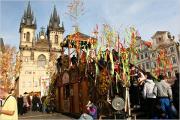Easter Markets in Prague

The Prague Easter markets open are daily from 12th March to 3rd April 2016 in Old Town Square and Wenceslas Square. The markets consist of brightly decorated wooden huts selling traditional hand crafts such as glassware, jewellery and puppets and dolls.
The most common sight at the markets are brightly coloured, hand-painted Easter eggs, which can be personalised for you by painting on a name or special message.
The Easter Markets are not just about shopping. Visitors can watch traditional foods being made, and sample lots of local produce. Large hams are roasted on spits, there are barbequed sausages (klobása), and cakes and pastries prepared in front of you, such as ‚Trdelník‘, a hot sugar coated pastry, sometimes these also come smothered in Nutella. As well as the great food, there are also many of the famous Czech beers to try – Pilsner Urquell, Staropramen and Budvar.
How to make the most of Prague’s Easter Markets ==
Prague’s city centre is compact, which is ideal for our clients who are recovering from surgery.
The Prague Easter markets are free to enter and are just a short tram or taxi journey from our recovery apartments, whenever you fancy dropping in, you can leave your apartment and be in the midst of the markets in minutes. Grab a drink, browse the stalls, and soak up the atmosphere.
Please remember that you must only venture out when your surgeon has said it is okay for you to do so. If at any point you start to feel tired or pain, please return to your recovery apartment as soon as possible and rest. Pushing your body to the limits in the first few days after surgery, can be detrimental to your recovery process.
Origins of the Easter Markets in Prague
Prague Easter Markets originate from a time long before the communist era and were deeply tied to religious festivities. Under communism the markets suffered a demise, as the religious aspects of Easter were banned and celebrations were limited to welcoming in spring.
Since the fall of communism, the markets have enjoyed a renaissance. Czechs and tourists come together in their thousands today, to browse the colourful market stalls and soak up the atmosphere.
Prague Easter Preparations
Children finish school on „Ugly Wednesday.“ The following day („Green Thursday“) boys equip themselves with wooden rattles, called „rehtacka“. They then form a group and walk through their local village or town, shaking their rattles vigorously. This, as tradition dictates, scares off Judas.
The same walk is repeated on „Good Friday“ and then once more on „White Saturday“. On Saturday, progress is slowed by the boys stopping at every house and shaking their rattles until they receive a present!
- Easter Sunday
The greatest symbol of Easter is the egg, with its connections of spring and new life. On Easter Sunday, the girls and women of the village paint eggs („kraslice“). This is a skilled affair with many variations on the decoration; usually a mixture of watercolours, picture stickers, bee’s wax, straw and/or feathers.
As girls paint their Easter eggs, the boys prepare their Easter whips („pomlázka“), ready for Easter Monday. This is not the kind of whip used on horses, but is made from osier twigs, braided together. Once again, this takes some skill to make and the more twigs, the more difficult it is to braid a whip.
Visitors may see examples of these Easter whips in the Prague markets, should they wish to participate!
- Easter Monday
On Easter Monday people get up early. The boys and men set off on a whipping trip through the village. Boys stop at people’s homes and whip the legs of every girl and woman who live in the house. Small boys are required to recite an Easter carol as they go about their whipping.
As if the whipping is not enough, a popular custom is also to grab the girl and throw her in a bath of cold water, known as an „Easter dousing“. The whipping and dousing is performed to chase away illness and bad spirits. They may not appreciate it at the time, but it is actually good for the girl!
Once all the whipping and dousing is over, the girl, strangely enough, rewards the boy with one of her painted eggs. She then ties a ribbon around his whip and he moves on to the next house.
As the boys progress through the village, their bags fill with eggs and the whips become more and more colourful, with many bright ribbons attached.
For older boys, gifts of eggs and ribbons have latterly given way to offers of shots of alcohol. By the time they arrive home, these young men can be fairly happy!
For more information, please call 0800 023 2592 free or apply for our free email consultation by filling in the medical questionnaire and sending us your photos.

